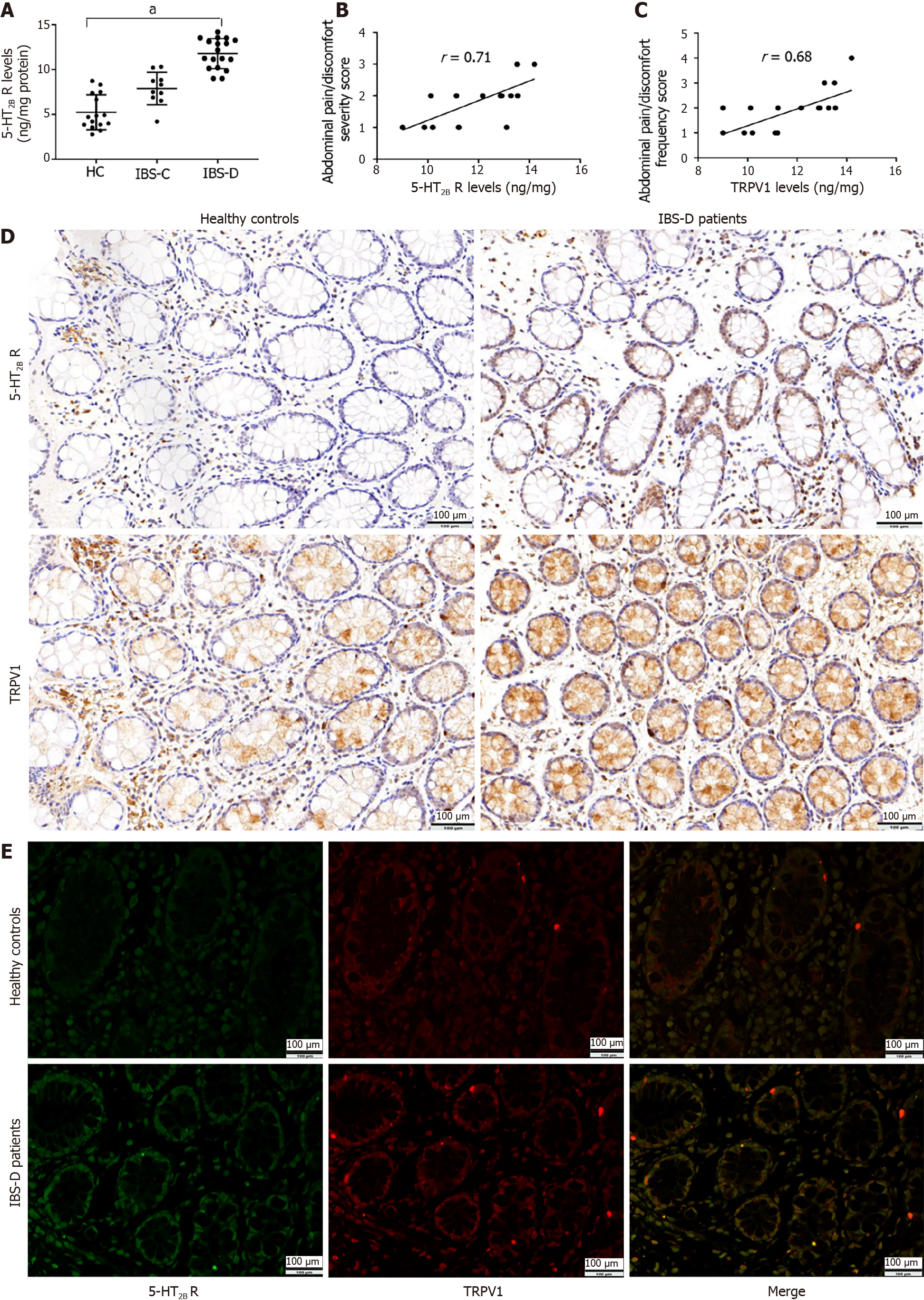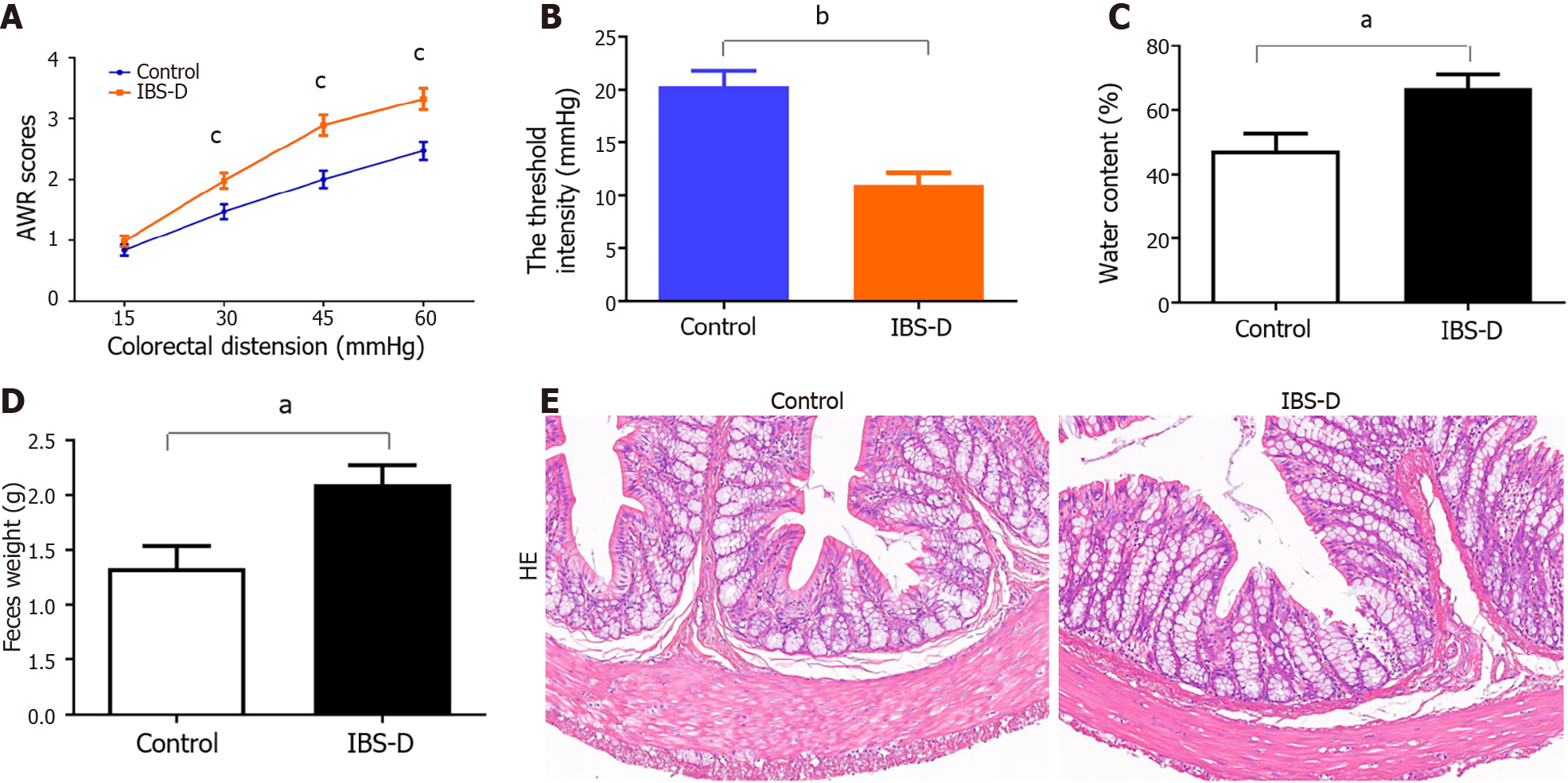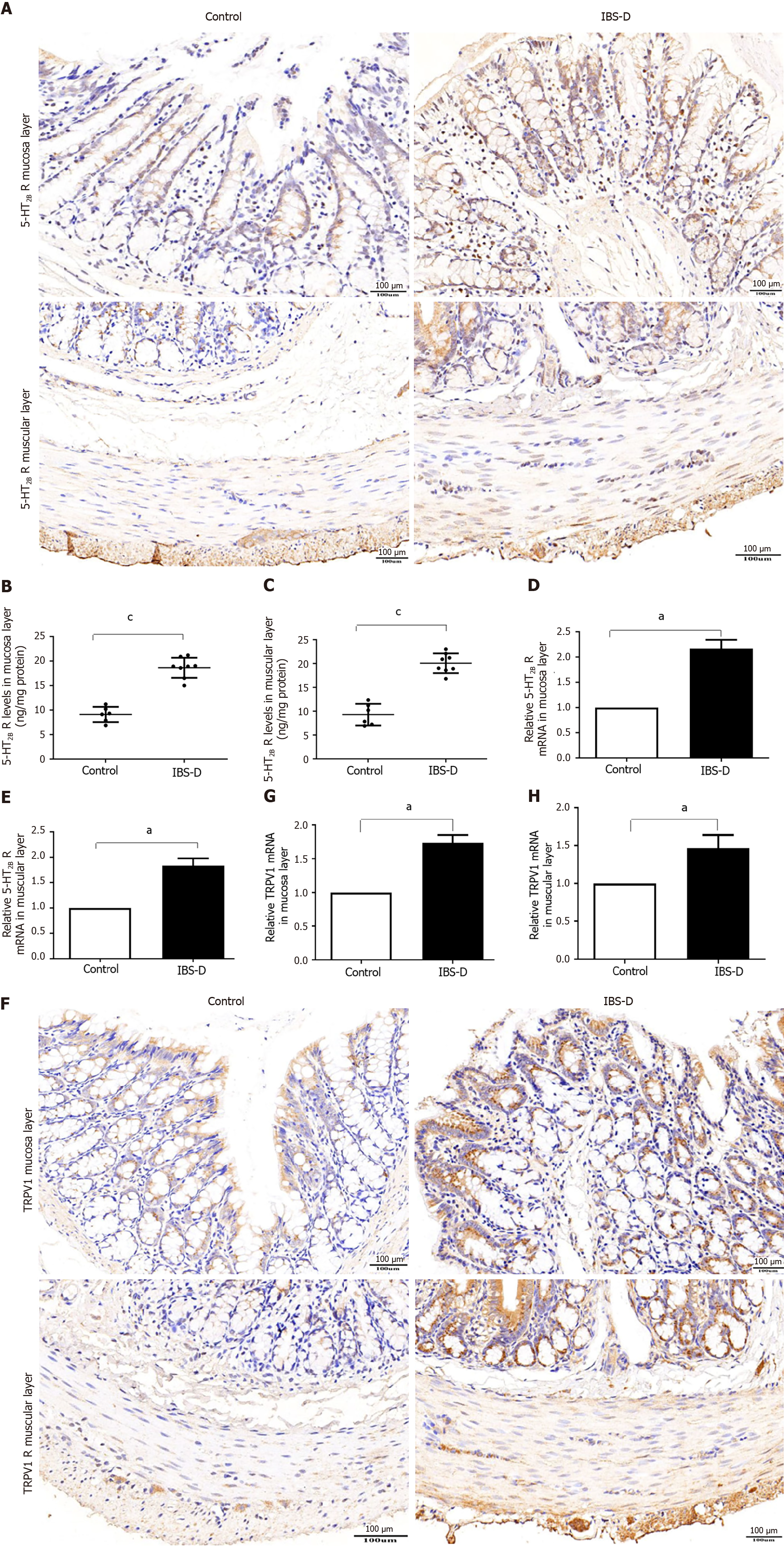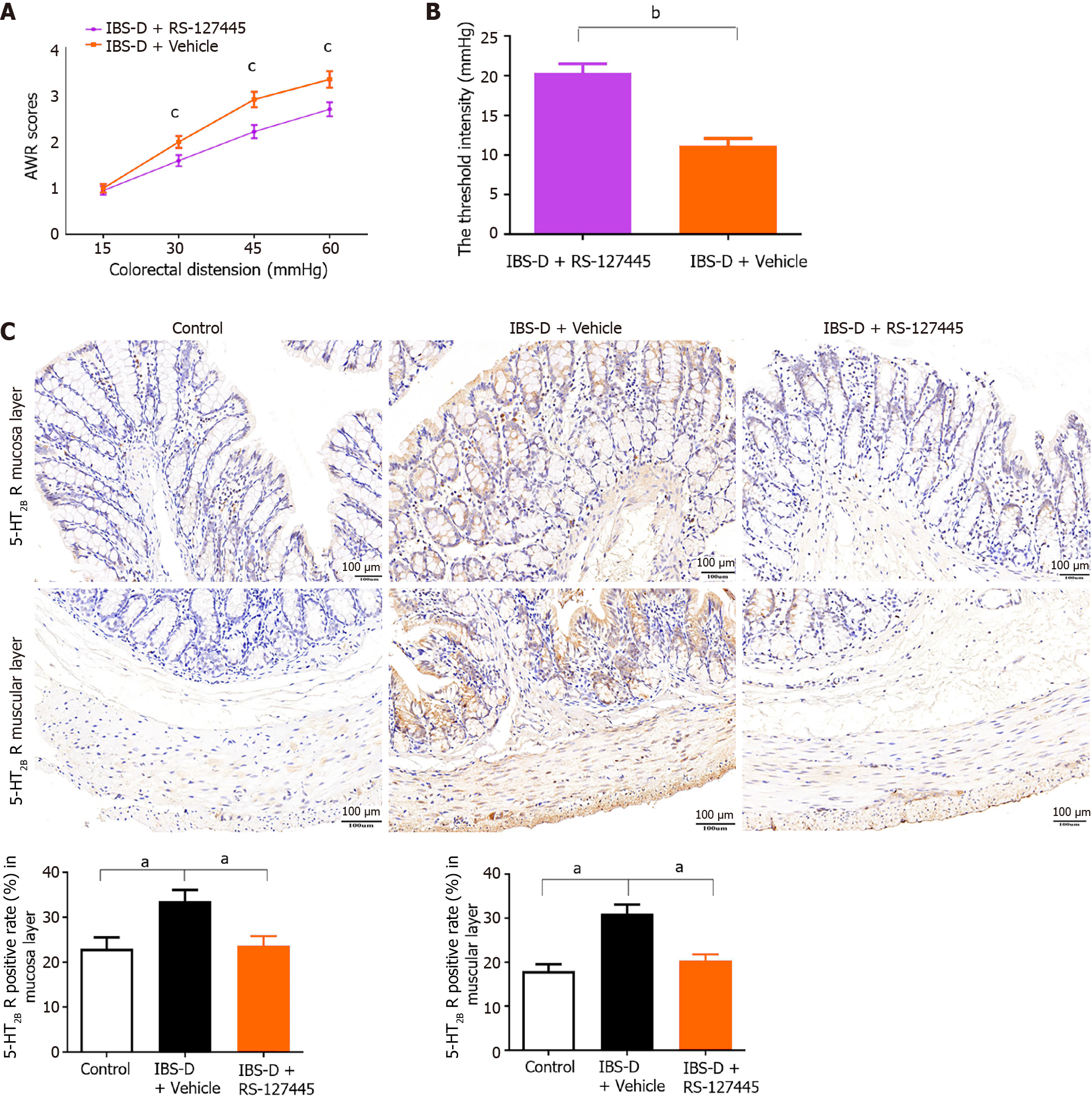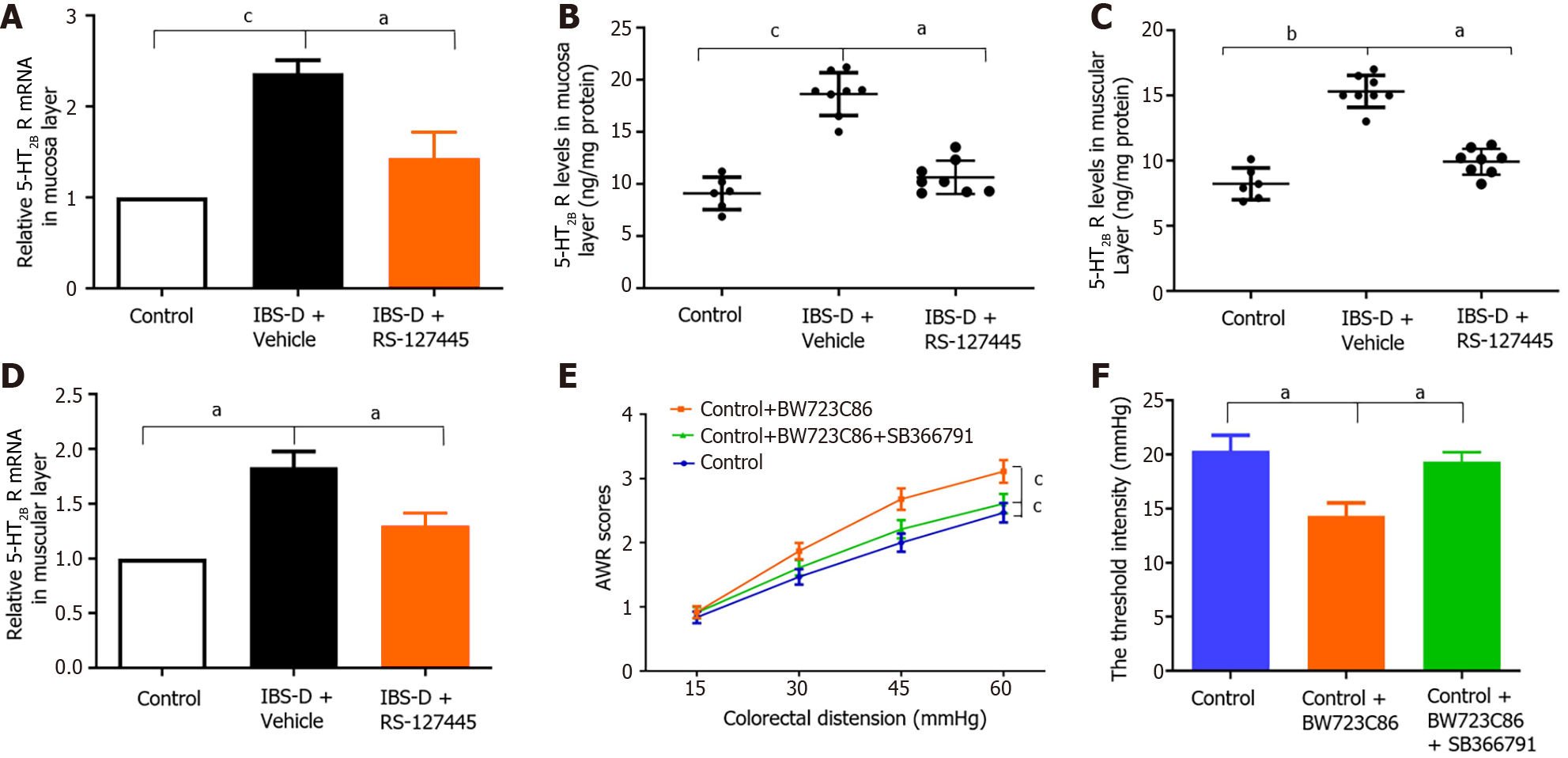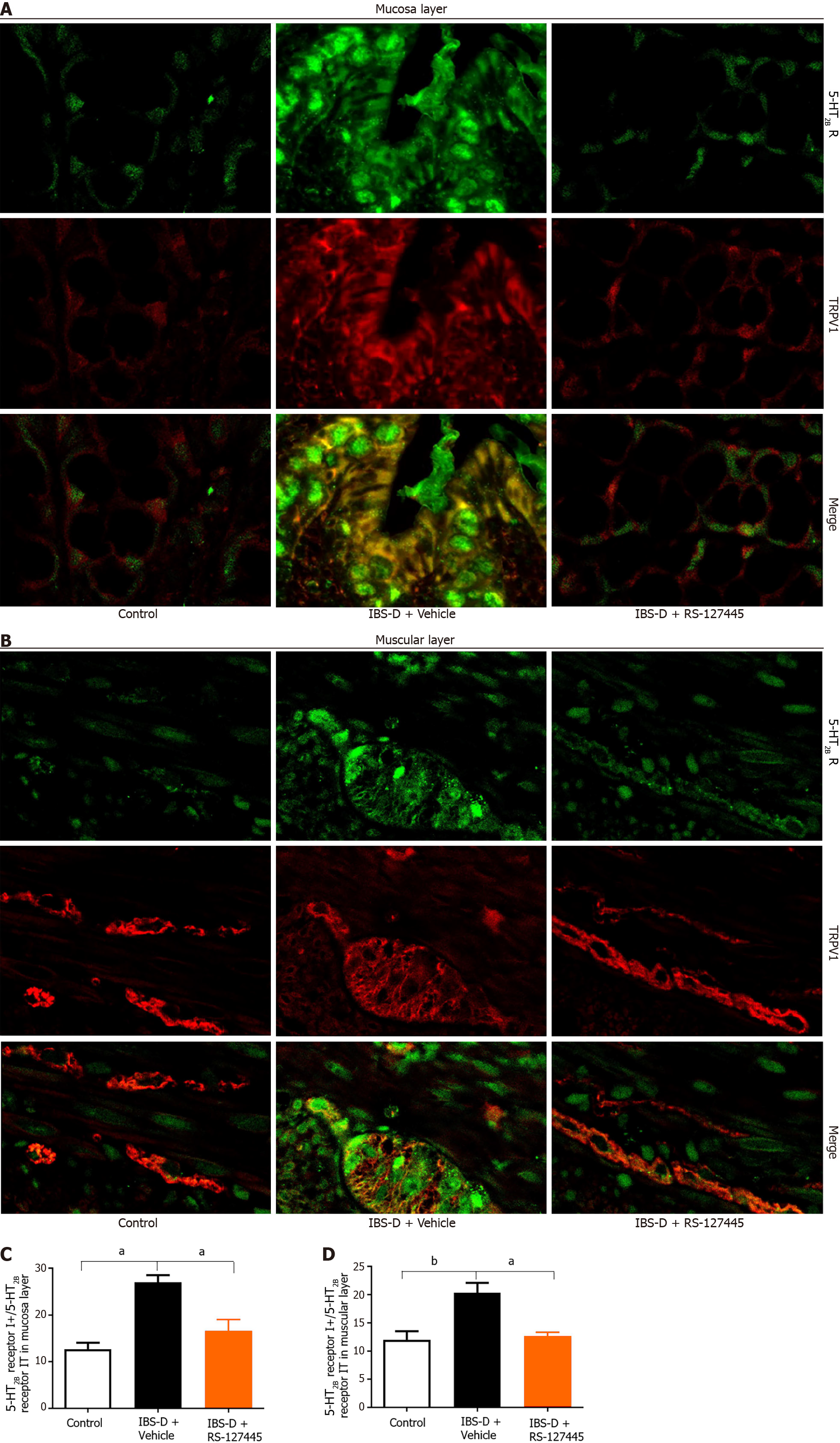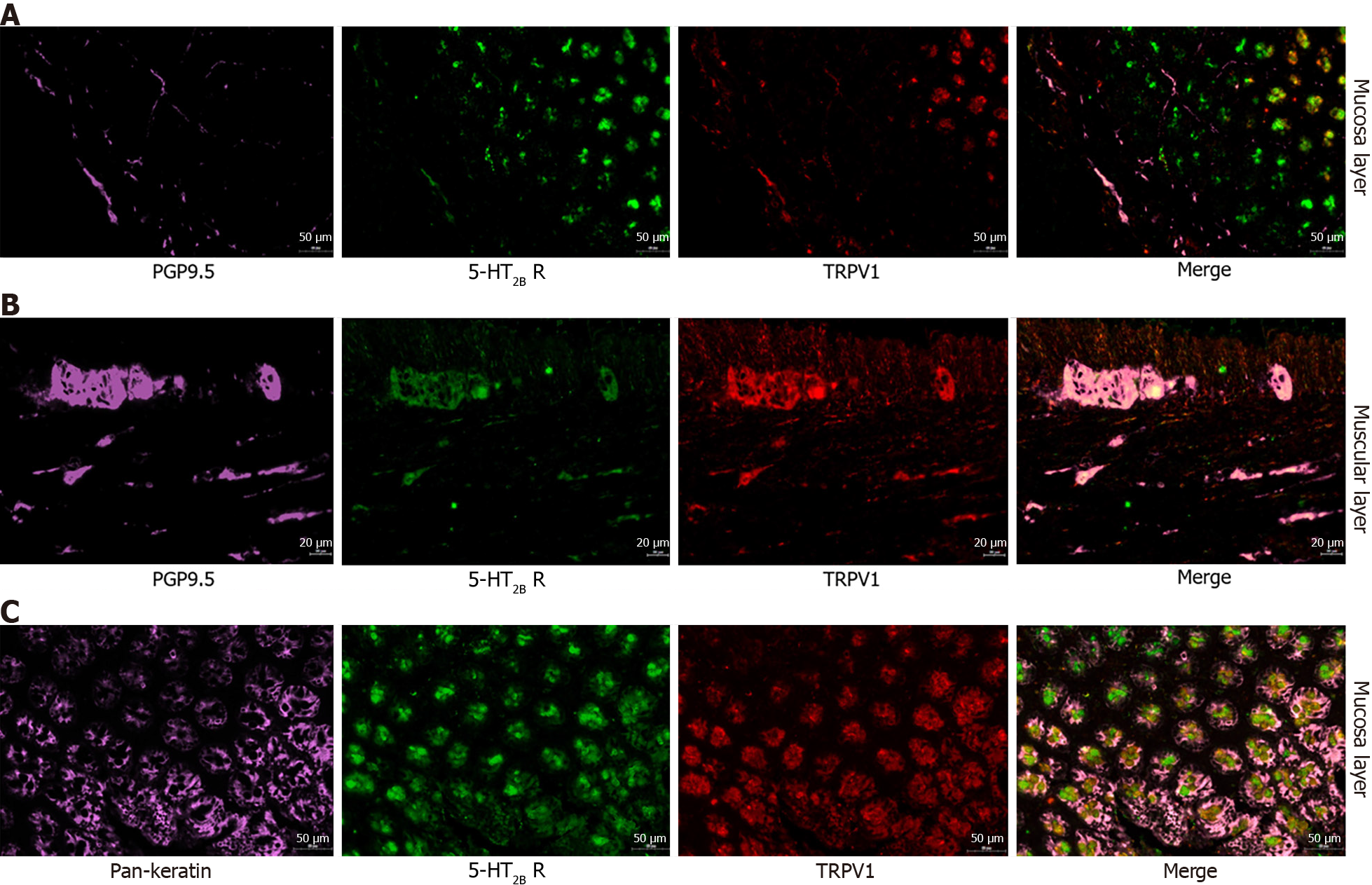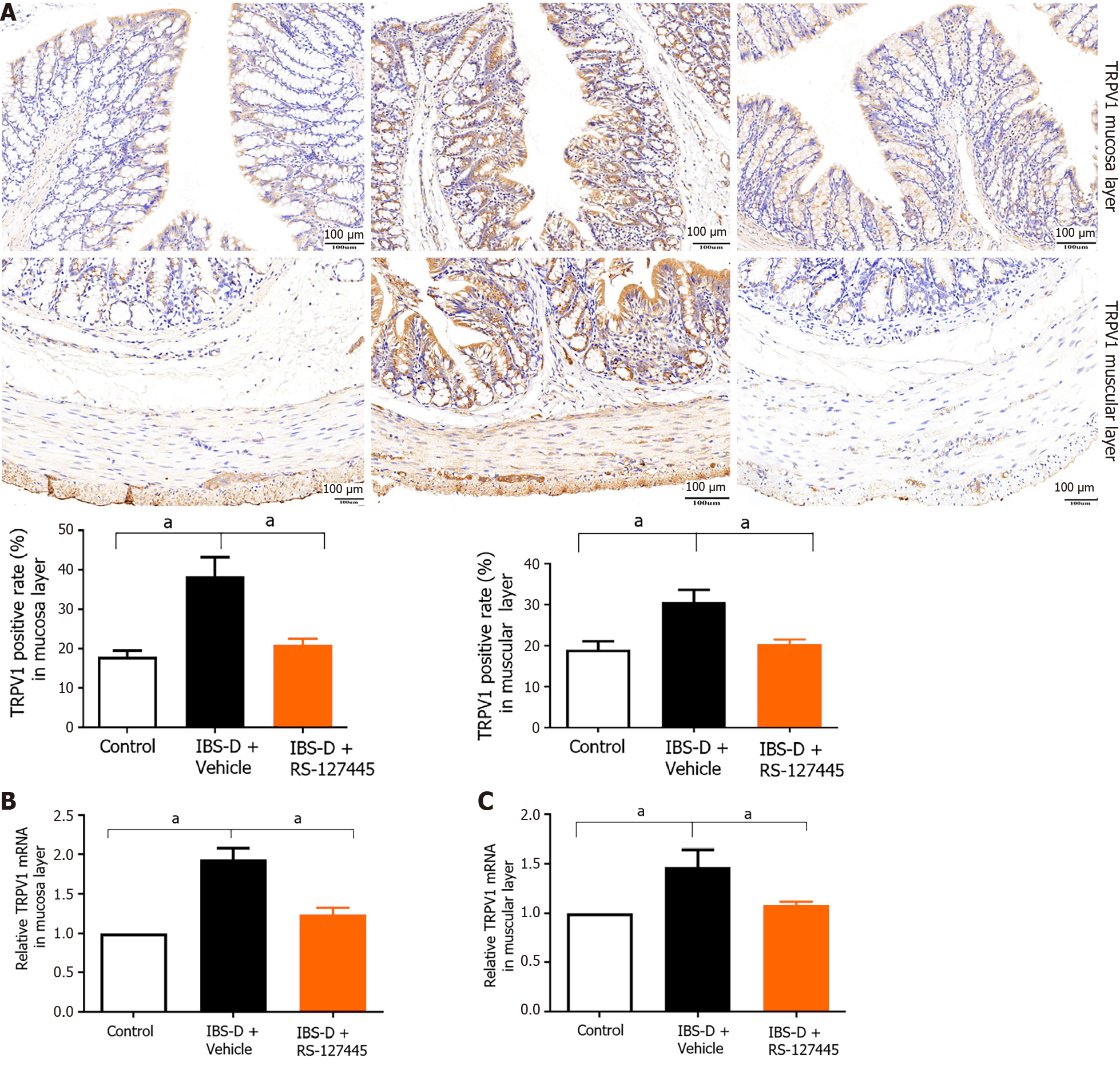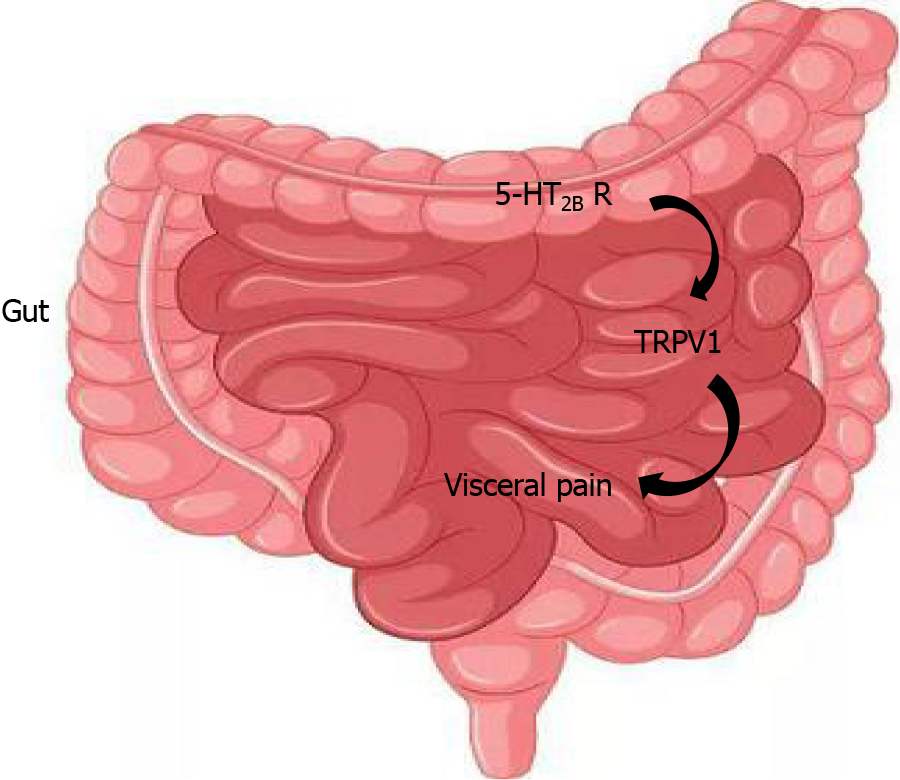Copyright
©The Author(s) 2024.
World J Gastroenterol. Mar 14, 2024; 30(10): 1431-1449
Published online Mar 14, 2024. doi: 10.3748/wjg.v30.i10.1431
Published online Mar 14, 2024. doi: 10.3748/wjg.v30.i10.1431
Figure 1 Irritable bowel syndrome with diarrhea patients presented increased serotonin receptor 2B and transient receptor potential vanilloid type 1 protein levels.
A: Expression of the serotonin receptor 2B (5-HT2B) receptor protein in colonic biopsies of patients with irritable bowel syndrome with diarrhea (IBS-D) (n = 18), patients with irritable bowel syndrome with constipation (n = 10), and control subjects (n = 15); B: Correlation between the severity of abdominal pain and the 5-HT2B receptor level in patients with IBS-D (Spearman correlation coefficient = 0.71, P = 0.001); C: Correlation between the frequency of abdominal pain and the 5-HT2B receptor level in patients with IBS-D (Spearman correlation, r = 0.68; P = 0.001); D: Representative photomicrographs showing positive 5-HT2B receptor and transient receptor potential vanilloid type 1 (TRPV1) immunoreactivity in two serial sections of biopsy tissues from healthy controls and IBS-D patients. The magnification was 20 ×; E: Double-label immunofluorescence analysis of the 5-HT2B receptor (green) and TRPV1 (red) in the colonic mucosa of healthy controls and IBS-D patients. Merged image showing colocalization (yellow) of the 5-HT2B receptor and TRPV1 immunoreactivity. Magnification 20 ×. aP < 0.05. IBS-C: Irritable bowel syndrome with constipation; IBS-D: Irritable bowel syndrome with diarrhea; 5-HT2B: Serotonin receptor 2B; HC: Healthy controls; TRPV1: Transient receptor potential vanilloid type 1.
Figure 2 Validation of the establishment of an irritable bowel syndrome with diarrhea rat model.
A: The irritable bowel syndrome with diarrhea (IBS-D) group had higher abdominal withdrawal reflex scores than did the normal control group, with colorectal distension pressures of 30, 45 and 60 mmHg but not 15 mmHg; B: The IBS-D group also had a decreased threshold pressure compared with that of the normal control group; C: The water content of the feces in the IBS-D group and normal control group; D: The weight of fecal pellets in the IBS-D group and normal control group; E: Inflammation evaluation of the colon in IBS-D rats and normal control rats using hematoxylin and eosin stain. No significant inflammation or abnormalities in structure were observed in IBS-D rats or normal control rats. Magnification 20 ×; aP < 0.05, bP < 0.01, cP < 0.001. IBS-D: Irritable bowel syndrome with diarrhea; HE: Hematoxylin and eosin; AWR: Abdominal withdrawal reflex.
Figure 3 Increased serotonin receptor 2B and transient receptor potential vanilloid type 1 levels in the irritable bowel syndrome with diarrhea group.
A: Immunohistochemical staining revealed the expression of the serotonin receptor 2B (5-HT2B receptor) in the colon tissue in irritable bowel syndrome with diarrhea (IBS-D) rats and normal control rats; Magnification 20 ×; B: Expression of 5-HT2B receptor protein in the colonic mucosa layer of the IBS-D group and normal control group; C: Expression of 5-HT2B receptor protein in the colonic muscular layer of the IBS-D group and normal control group; D: Levels of 5-HT2B receptor mRNA in the colonic mucosa layer from the IBS-D group and normal control group; E: Levels of 5-HT2B receptor mRNA in the colonic muscular layer from the IBS-D group and normal control group; F: Immunohistochemical staining showing the expression of transient receptor potential vanilloid type 1 (TRPV1) in the colon tissue in IBS-D rats and normal control rats. Magnification 20 ×; G: Levels of TRPV1 mRNA in the colonic mucosa layer from the IBS-D group and normal control group; H: Levels of TRPV1 mRNA in the colonic muscular layer from the IBS-D group and normal control group. aP < 0.05, cP < 0.001. IBS-D: Irritable bowel syndrome with diarrhea; 5-HT2B: Serotonin receptor 2B; TRPV1: Transient receptor potential vanilloid type 1.
Figure 4 RS12-7445 decreased the visceral sensitivity and serotonin receptor 2B levels in irritable bowel syndrome with diarrhea rats.
A: The irritable bowel syndrome with diarrhea (IBS-D) + Vehicle group had significantly greater abdominal withdrawal reflex scores than did the IBS-D + RS-127445 group with the same colorectal distension (CRD) pressure; B: The IBS-D + Vehicle group had significantly reduced threshold pressure than did the IBS-D + RS-127445 group with the same CRD pressure; C: Immunohistochemical staining showing the expression of the serotonin receptor 2B receptor in the colon mucosa layer and colon muscular layer of each group. Magnification 20 ×; aP < 0.05, bP < 0.01, cP < 0.001. IBS-D: Irritable bowel syndrome with diarrhea; 5-HT2B: Serotonin receptor 2B; AWR: Abdominal withdrawal reflex.
Figure 5 RS12-7445 decreased the serotonin receptor 2B levels in irritable bowel syndrome with diarrhea rats.
Visceral sensitivity was detected by the colorectal distension. A: Serotonin receptor 2B (5-HT2B receptor) mRNA levels in the colonic mucosa layer were detected via quantitative reverse transcriptase polymerase chain reaction (qRT-PCR); B: Expression of the 5-HT2B receptor in colon mucosa tissues from each group was detected by ELISA; C: Expression of the 5-HT2B receptor in colon muscular tissues from each group was detected by ELISA; D: 5-HT2B receptor mRNA levels in the colonic muscular layer were detected via qRT-PCR; E: The Control + BW723C86 group had higher abdominal withdrawal reflex (AWR) scores than did the Control group, with colorectal distension (CRD) pressures of 30, 45 and 60 mmHg but not 15 mmHg. Similarly, the Control + BW723C86 group had increased AWR scores with the same CRD pressure compared with those of the Control + BW723C86 + SB366791 group; F: The Control + BW723C86 group had a decreased threshold pressure compared with that of the Control group. Similarly, the Control + BW723C86 group had reduced threshold pressure with the same CRD pressure compared with those of the Control + BW723C86 + SB366791 group. aP < 0.05, bP < 0.01, cP < 0.001. IBS-D: Irritable bowel syndrome with diarrhea; 5-HT2B: Serotonin receptor 2B; AWR: Abdominal withdrawal reflex.
Figure 6 Double-label immunofluorescence analysis in the rat colon.
A and B: Double-label immunofluorescence analysis of serotonin receptor 2B (5-HT2B receptor) (green) and transient receptor potential vanilloid type 1 (TRPV1) (red) in the colon mucosa layer (A) and muscular layer (B) in normal control rats, irritable bowel syndrome with diarrhea (IBS-D) + Vehilce rats and RS-127445-treated IBS-D rats. Merged image showing colocalization (yellow) of the 5-HT2B receptor and TRPV1 immunoreaction. Magnification 20 ×; C: The data are the percentages of 5-HT2B receptor I+ cells in the colon mucosa layer among the total 5-HT2B receptor-immunoreactive (IR) cells in the colon mucosa layer (5-HT2B receptor IT); D: The data are presented as the percentage of 5-HT2B receptor I+ cells in the colon muscular layer relative to the total 5-HT2B IR cells in the colon muscular layer (5-HT2B receptor IT). aP < 0.05, bP < 0.01. IBS-D: Irritable bowel syndrome with diarrhea; 5-HT2B: Serotonin receptor 2B; TRPV1: Transient receptor potential vanilloid type 1.
Figure 7 Immunofluorescence analysis of colon tissues costained with serotonin receptor 2B (green fluorescence), transient receptor potential vanilloid type 1 (red fluorescence), protein gene product 9.
5 (purple fluorescence) and Pan-Keratin (purple fluorescence). A: Serotonin receptor 2B (5-HT2B receptor) receptor (green fluorescence), transient receptor potential vanilloid type 1 (TRPV1) (red fluorescence) and protein gene product 9.5 (PGP9.5) (purple fluorescence) in the rat colon mucosa layer. Merged image showing colocalization (pink) of the 5-HT2B receptor, TRPV1 receptor and PGP9.5 immunoreactivities in the rat colon mucosa layer; B: 5-HT2B receptor (green fluorescence), TRPV1 (red fluorescence) and PGP9.5 (purple fluorescence) in the rat colon muscular layer. Merged image showing colocalization (pink) of the 5-HT2B receptor, TRPV1 receptor and PGP9.5 immunoreactivities in the rat colon muscular layer; C: The 5-HT2B receptor (green fluorescence), TRPV1 (red fluorescence) and Pan-Keratin (purple fluorescence) in the rat colon mucosa layer. Merged image showing colocalization (pink) of the 5-HT2B receptor and TRPV1 and pankeratin immunoreactivities in the rat colon mucosa layer. Magnification 20 ×. PGP9.5: Protein gene product 9.5; 5-HT2B: Serotonin receptor 2B; TRPV1: Transient receptor potential vanilloid type 1.
Figure 8 RS12-7445 decreased the transient receptor potential vanilloid type 1 levels in colon tissues in irritable bowel syndrome with diarrhea rats.
A: Immunohistochemical staining showing the expression of transient receptor potential vanilloid type 1 (TRPV1) in the colon mucosa layer and colon muscular layer of each group. Magnification 20 ×; B: Levels of TRPV1 mRNA in colon mucosa layer tissues were measured by quantitative reverse transcriptase polymerase chain reaction (qRT-PCR); C: Levels of TRPV1 mRNA in colon muscular layer tissues were measured by qRT-PCR. aP < 0.05. IBS-D: Irritable bowel syndrome with diarrhea; TRPV1: Transient receptor potential vanilloid type 1.
Figure 9 The visceral pain conduction pathway involves transient receptor potential vanilloid type 1.
The expression of the serotonin receptor 2B (5-HT2B) receptor and transient receptor potential vanilloid type 1 (TRPV1) increased in colon tissues from irritable bowel syndrome with diarrhea patients and rats. The administration of a 5-HT2B receptor agonist increased visceral pain, which was alleviated by successive administration of a TRPV1 antagonist. Treatment with a 5-HT2B receptor antagonist suppressed TRPV1. The sensation of pain is thus attenuated, and the pain threshold is increased. 5-HT2B receptor: Serotonin receptor 2B; TRPV1: Transient receptor potential vanilloid type 1.
- Citation: Li ZY, Mao YQ, Hua Q, Sun YH, Wang HY, Ye XG, Hu JX, Wang YJ, Jiang M. Serotonin receptor 2B induces visceral hyperalgesia in rat model and patients with diarrhea-predominant irritable bowel syndrome. World J Gastroenterol 2024; 30(10): 1431-1449
- URL: https://www.wjgnet.com/1007-9327/full/v30/i10/1431.htm
- DOI: https://dx.doi.org/10.3748/wjg.v30.i10.1431













